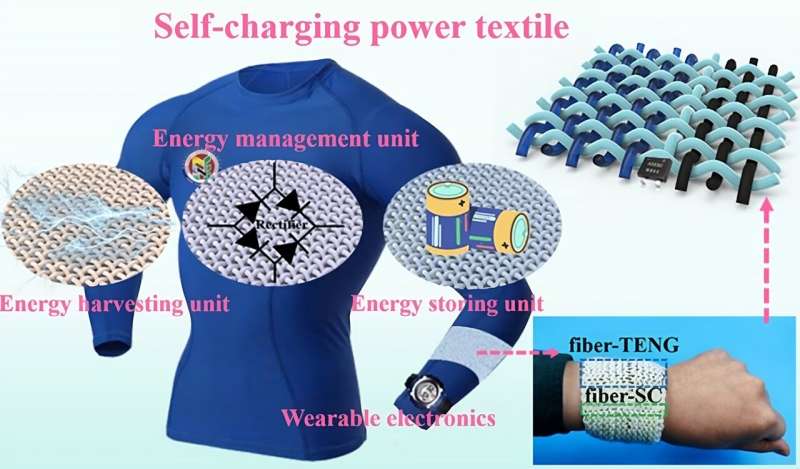This article has been reviewed according to Science X's editorial process and policies. Editors have highlighted the following attributes while ensuring the content's credibility:
fact-checked
proofread
Wearable textile captures energy from body movement to power devices

Nanoscientists have developed a wearable textile that can convert body movement into useable electricity and even store that energy. The fabric potentially has a wide range of applications from medical monitoring to assisting athletes and their coaches in tracking their performance, as well as smart displays on clothing.
The research team responsible for the textile describe how it works in a paper published in Nano Research Energy.
From smart watches to cordless headphones, people already have access to a wide range of wearable electronic devices. A range of health, sport and activity monitors are now integrated into smartphones.
But the accuracy of such sensors remains limited due to the handful of locations on or near the body that they can be placed, and restricted to a small window of applications compared to the ambitions of many health and sporting specialists have for such technology.
In the future, if advanced fabrics can be developed, then perhaps wearable electronic devices integrated into shirts, pants, underwear and hats will be able to track indicators of frailty to assess risk of age-related disease, monitor cortisol levels to track stress levels, or even detect pathogens as part of a global pandemic monitoring network.
To take wearable electronics to this next level, to integrate health monitors, sport sensors, navigation systems and activity trackers into clothing in a way that is lightweight, unobtrusive and less cumbersome still requires some major breakthroughs in advanced textiles.
One of the challenges of existing wearable electronics comes from limitations in the flexibility and thus wearability of the components that supply energy to the devices. In addition, energy supply units need to be easily integratable with the devices and, in an era of increased environmental awareness, sustainable. On top of all this, existing energy storage technologies have very limited capacity. Batteries and supercapacitors can store energy, but they cannot produce energy spontaneously without an external power source.
"Batteries are also just not very comfortable to wear," said Feifan Sheng, lead author of the paper and nano systems specialist with the Beijing Institute of Nanoenergy and Nanosystems at the Chinese Academy of Sciences. "So the development of wearable and self-charging power supplies is crucial."
Professor Dong's team of nanoscientists produced what they call a "fiber-TENG," a flexible, knittable, wearable structure that takes advantage of the triboelectric effect, in which certain materials become electrically charged after coming into frictional contact with another, different material. Commonplace static electricity for example involves the contact-induced electrification of tribolelectric effect.
The fiber-TENG consists of three layers: a polylactic acid layer (a type of polyester commonly used in 3D printing), a reduced graphene oxide layer (a highly affordable type of graphene), and a polypyrrole layer (a polymer already widely used in electronics and medicine).
When the fiber-TENG is subjected to mechanical deformation, such as bending or stretching by the person wearing a piece of clothing knitted from the textile, the triboelectric charges generated by the contact between the polylactic acid and reduced graphene oxide layers can be collected by the polypyrrole layer. This process generates an electrical output that can be used as a power generation unit.
Key to the development of the fiber-TENG was a novel process used to prepare the graphene oxide fiber for use in a coaxial fiber-shaped supercapacitor (fiber-SC)—the energy storage facility integrated into the textile. A coaxial structure provides great stability when bending and twisting.
The process involves adding the active materials (those that can store and release electrical energy) onto the surface of reduced graphene oxide (rGO) fibers. First, the researchers produced the rGO fibers via an application of hydroiodic acid. Then, they add two active materials, manganese dioxide (MnO2) and polypyrrole (PPy), onto the surface of the rGO fibers using a process called electrodeposition—a method of depositing a material onto a surface by applying an electric current.
This created a negative electrode material called rGO-PPy-MnO2 that is used in the fiber-SC. A positive electrode material was then made by uniformly coating multi-walled carbon nanotubes (MWCNTs) with polyvinyl alcohol and phosphoric acid electrolyte on the surface of the rGO-PPy-MnO2.
Testing their fiber-TENG textile, the researchers found that it enjoys high energy density and lengthy stability over charge and discharge cycles, enhancing its promise in delivering wearable energy generation and storage.
The team now want to start exploring potential uses of their textile in real-world applications. For this, they will need to optimize the design and fabrication process of the power textile, and to investigate its performance under different conditions, as well as develop a scalable manufacturing process workable in commercial operations beyond the lab.
More information: Feifan Sheng et al, Wearable energy harvesting-storage hybrid textiles as on-body self-charging power systems, Nano Research Energy (2023). DOI: 10.26599/NRE.2023.9120079
Provided by Tsinghua University Press




















